Group Size
?
1.) Small group (teams of 4-6)
2.) Individual Task
3.) Large Group
4.) Any
Small group (teams of 4-6)
Learning Environment
?
1.) Lecture Theatre
2.) Presentation Space
3.) Carousel Tables (small working group)
4.) Any
5.) Outside
6.) Special
Carousel Tables (small working group)
QAA Enterprise Theme(s)
?
1.) Creativity and Innovation
2.) Opportunity recognition, creation and evaluation
3.) Decision making supported by critical analysis and judgement
4.) Implementation of ideas through leadership and management
5.) Reflection and Action
6.) Interpersonal Skills
7.) Communication and Strategy
1Creativity and Innovation
4Implementation of ideas through leadership and management
6Interpersonal Skills
7Communication and Strategy
This case study describes a speed networking event that enables 1st years Computing and Business students to engage with Level 6 students in ‘live’ projects.
Level 4 student teams compete for business opportunities by attending a networking fair and engagement with level 6 students. The task is supported by in-class activities, but the emphasis is on learning by doing. Students are encouraged to reflect on the experience as part of the assessment strategy.
Participation at the event forms part of both year group’s module assessment. At the beginning of the academic year, final year student teams identify a year long project opportunity. They meet the client and develop a project to deliver to them. In the 2nd semester, Level 4 student teams are introduced to key concepts of business development and prepare to engage with Level 6 students at the speed networking event. In preparation for the event, Level 6 groups prepare project briefs. These briefs create a ‘mini’ market place for Level 4 groups to segment and target based on their own team goals. Typically, the students work in teams of four. After the Speed Networking event the teams from level 4 and 6 work together to complete their part of the project.
Specifically, students at level 4 prepare by developing an understanding of the start up business cycle. Such as team formation, start up strategy and product/ service development. Students are given prior knowledge of potential projects, which helps them target their pitch and brand. They learn to create rudimentary business artefacts such as a brand name; business cards and a sales pitch (see photo attachment). Students were also guided on networking skills, such as body language and professionalism.
Students at Level 6 prepare by developing a project plan with their project client. During the delivery phase of the project. They identify an outsourcing opportunity and produce a project brief, roughly 1 month in advance of the event. A pro-forma is provided to create a consistent look and feel to each teams brief, so that level 4 students can easily assess the merits of each potential project brief (see attachment). Around 20 projects are created by the cohort, which roughly matches the number of teams at level 4. The supply of projects can be increased by Level 6 students creating more than 1 outsourcing project. Projects range from simple tasks, such as logo design to more complex projects, such as research, web development, and media production.
The project clients are typically from external organisations, such as charities and local businesses, but can be internal clients, such as, as tutors. Project size for level 6 students should be complex enough too ensure that the challenge provides adequate work for each team member. The sub task project for Level 4 can be relatively simple. It is more essential to engender confidence and good team work at Level 4.
The competitive nature of the event means that teams are not guaranteed to get what they want. Success is often determined by the quality of planning carried out in advance of the fair, or by the professionalism of the team on the day.
The event is very popular and student engagement in the event is close to 100%, with around 150 participants. While conducting the task, students have very little time to become distracted, which means that they receive the full benefit of the session.
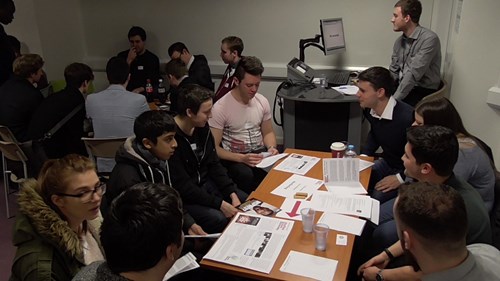
Student feedback comments are also very positive:
Verbal and scored Feedback
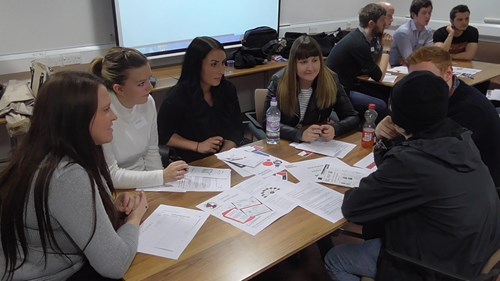
National Student Survey feedback comments single out the modules as a key benefit from the course.
“I really enjoy this course, as it's stimulating and pushes my boundaries. I have noticed vast improvements in my abilities, in terms of communication, presenting and teamwork. All staff are very helpful in terms of problem solving and it's nice to know that the support is there when needed. I enjoy the course content and how interactive the course is.” NSS 2015
“The course really targets employability and it really appeals to employers that we gain hands-on business skills.” NSS 2015
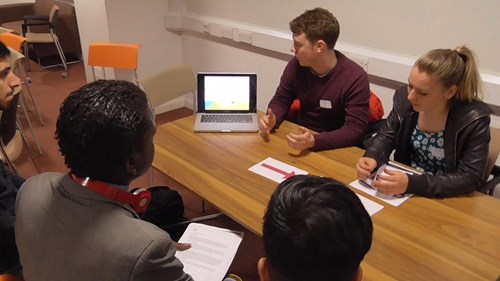
Students learn the benefit of planning and preparation. They also understand that it is difficult to communicate in a time pressured environment. An interesting side effect of the event, is that students in level 4 can benefit from a peer mentoring experience; learn about the course and how to be successful at gaining a placement. The event is also a novel learning experience and adds a new dimension to the university experience. Final year students benefit from the reflection of ‘how they used to be’, which adds to their confidence.
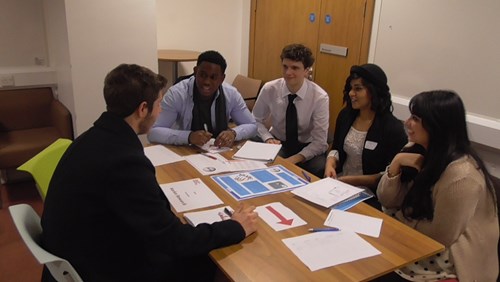
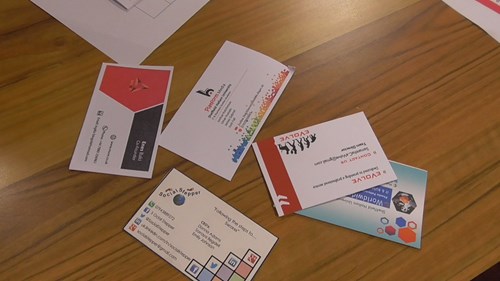
Contact details: Dr Andrew Hirst, Teaching Fellow in Work Based Learning, Sheffield Hallam University https://www.linkedin.com/in/drandrewhirst